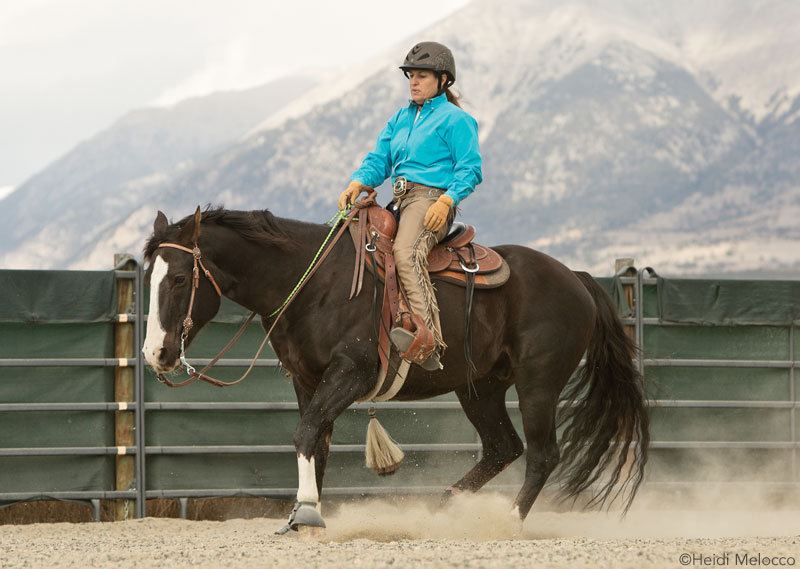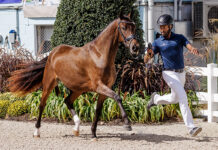Riding without a bridle is the ultimate proof that you have an obedient and willing equine partner. To achieve that goal, you need to rely more on your body cues and less on the reins.
“It all starts with obedience,” says trainer and clinician Julie Goodnight. “It’s never safe to take the bridle off of a horse that isn’t obedient to your voice, body and seat cues 100 percent of the time.
Here, Goodnight shares her strategies for establishing authority with your horse while sharpening your riding skills.
Riding without a bridle is the ultimate proof that you have an obedient and willing equine partner. To achieve that goal, you need to rely more on your body cues and less on the reins. Even if you never choose to take off your horse’s bridle, the training process helps you clarify your cues, makes you less reliant on the reins, and helps your horse learn to respond to your subtle body shifts.
“It all starts with obedience,” says trainer and clinician Julie Goodnight. “It’s never safe to take the bridle off of a horse that isn’t obedient to your voice, body and seat cues 100 percent of the time.”
Here, Goodnight shares her strategies for establishing authority with your horse while sharpening your riding skills.
Changing Your Cues
What does it take to reach the goal of riding bridleless? Goodnight says that it requires you to change your mindset. You must expect obedience from your horse at all times and begin riding with a different set of cues, using your body position more and your reins less. To even think of taking off the bridle, you must be able to trust your horse to follow your cues without constant need of reinforcement.
“When you ride without a bridle, you’ll use your center of gravity, leg pressure and the position of your body,” says Goodnight.
Riding without Reins (Almost)
Goodnight says she often sees riders pick up the reins first to give a cue, but that won’t work if you’re going to ride bridleless one day. “It’s subconscious and habitual to go to the reins first, but pulling on the reins as a primary cue doesn’t give your horse a chance to obey the cue,” she explains. “You have to make a mental shift to think, ‘I will use my seat and leg cues first. My reins are only for reinforcement.’
“When your horse needs a reinforcement, it needs to come quickly and smoothly,” Goodnight continues. “If you give a cue, your horse should respond immediately, or you need to pick up the reins to reinforce it. Reinforcement should come within one second of the cue.”
However, you don’t want to be too abrupt with your rein reinforcement. “Always pick up the reins smoothly and deliberately,” says Goodnight. “If you’re too quick and jerky, your horse becomes reactive to rein aids. When you promptly and smoothly reinforce your cues, your horse will become responsive and willingly obey.”

Will Your Horse Go Bridleless?
Now that you know what it takes to ride bridleless, test your horse’s skills and find out how ready you are. With the bridle in place, warm up in an enclosed arena. To start Goodnight’s test, pick out a target point in the distance and ask your horse to go straight to that point. For example, ride down the long side of the arena while choosing to look at a tree or marker at the other end.
Lay your rein hand down on your horse’s withers so that you touch the saddle pad and keep your reins loose. This will neutralize your reins so that they’re at the ready but aren’t placing any pressure on your horse’s mouth. Goodnight likes to tuck her fingers under the saddle pad to ensure that she doesn’t use the reins too much. Ride straight toward your goal point without rein pressure to find out if your horse can stay on track.
“This test helps you know if you have been guiding your horse too much or if you can trust him to obediently follow your path,” Goodnight says. “You’ll know that your horse has little respect for your authority if you have to constantly guide him; if he pulls towards the middle of the arena; if he slows down as you pass the arena gate; or if he speeds up because you loosened the reins.”
If you feel the need to make constant corrections during the test, you have developed what Goodnight calls a “codependent relationship” with your horse. An obedient horse should go in the direction you tell him, until you instruct him to go somewhere else. If you have to hold him on the path or compromise the direction, you play into his disobedience, creating a cycle.
“You have to break the codependent cycle and let him know he must stay on your course,” Goodnight says. “If you drop your rein hand to neutral and your horse immediately changes course, lift your reins and firmly redirect him to the path. Then immediately drop your hand to neutral again.”
Goodnight says your horse must accept your authority and stay on the path you dictate before you can continue with bridleless training. If you had to correct your horse multiple times during the initial test, keep working on straight lines along the arena rail.
Increase the Challenge: Riding off the Rail
Once your horse will stay on the rail with your rein hand down on his neck, move to the middle of the arena to make it more challenging. Your horse won’t have the visual aid of the fence to help him know where to go. Ride in straight lines across the arena on the diagonals and quarterlines. Keep your hand in a neutral position, but be willing and ready to quickly reinforce your cues with the reins.
“Be aware of your horse’s shoulders, ribs or hips ‘bulging’ toward the direction he would like to go instead of toward your objective,” Goodnight says. “Add leg pressure or correct with your reins to keep your horse moving straight ahead. Moving any body part away from the straight line is off-course.”
Once your horse obeys your request for straightness, test his willingness to move with straightness at any gait. “He should maintain a steady speed on a loose rein,” says Goodnight. “If he speeds up when you loosen the reins, correct him immediately with your reins and seat, then loosen the reins and expect him to stay at the speed you dictate.
“Only work at the trot if your horse is obeying your cues at the walk,” adds Goodnight. “And only move to the canter if the trot feels secure and your horse is staying straight and at a steady speed without constant reinforcement.”
Finally, working at a walk, cue your horse to turn using just your legs. Reinforce your leg cues with your reins if needed, then quickly return your rein hand to neutral. This will determine if your horse relies on your rein aids to turn. Only allow a turn if you asked for it.
Consistent Cueing
Your test results will show you how obedient your horse is and what you have to work on. As you continue to practice, keep in mind that horses can sense your every move and are capable of tuning in to your signals very quickly—if you are clear and consistent.
“In every clinic I give, I ask the riders to turn their horses without rein aids and to start their cue by looking where they want to go,” Goodnight says. “I teach them to open their shoulders and arms into the turn, letting their whole bodies shift in the direction they are turning (all the way down to their feet), and reinforce their body cues with a bump of the inside rein if the horse doesn’t respond within a second. Within five minutes, all 15 horses in the clinic consistently turn without rein pressure. Your horse learns new cues quickly if he has consistent cues and reinforcement.”
Remember that you can pick up the reins at any time to correct your horse’s direction or speed if he doesn’t listen to the guiding cues of your legs, upper body and arms. Correct within one second of your first cue. Once your horse is 100 percent obedient going straight, at faster gaits and through turns, you can start working on developing the additional cues you’ll need to ditch the bridle.
Read part two of Julie Goodnight’s Bridleless Series >>
Read part three of Julie Goodnight’s Bridleless Series >>
This article originally appeared in the March 2014 issue of Horse Illustrated. Click here to subscribe.







This is very helpful, thank you.
This will be my next thing to teach my horse, thanks for all the great training tips, love them.
well i did this at WEG Kentucky during the breed display of the marwari breed show it just wonderful wish more folks learn to bond with their horses and ride with out a bit
great information as I just changed to a sidepull and need to work more on bridleless responses.
Awesome! What’s the thing hanging from her cinch between her horse’s legs?
I would love to try this driving!
Liked the article, and would like to know more about any practice that eases the burdens inflicted on riding horses. Re: Video & book entitled, “The Path Of The Horse” — What is the prevailing collective opinion of vets, trainers, horse people in general re: the theories put forth in “Path Of” video/book. Are there any disputes that challenge the theory that even the most gentle & highly-shooled riders inflict pain and injury on horses every time they mount? Rethinking my plan to get back to riding after a 30 year absence from the activity — so would be most grateful for any/all responses.